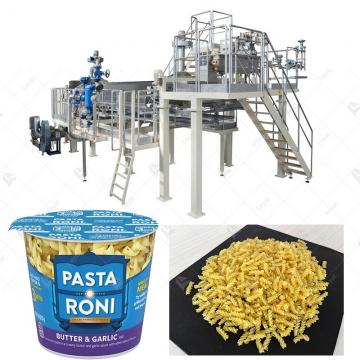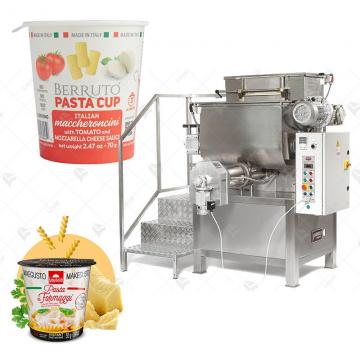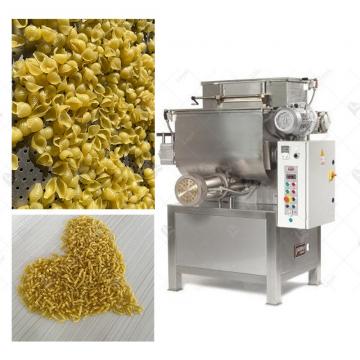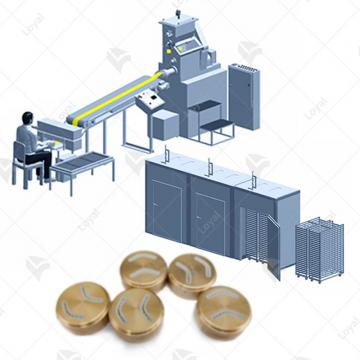
- Shandong Loyal Industrial Co.,Ltd.
- SHORT-CUT PASTA PRODUCTION LINE LONG-CUT PASTA PRODUCTION LINE INSTANT PASTA PRODUCTION LINE
Home> Company News> The Ultimate Guide to Dry Pasta Press Machines in 2024

The Ultimate Guide to Dry Pasta Press Machines in 2024
2024-03-28 11:03:41A dry pasta press machine is a vital piece of equipment in the pasta production industry, playing a crucial role in the manufacturing process. These machines are designed to efficiently and precisely shape pasta dough into various forms, meeting the diverse demands of consumers worldwide.
Definition and Purpose of Dry Pasta Press Machines
A dry pasta press machine is a specialized piece of equipment used in the pasta production industry to shape and form dry pasta products. These machines play a crucial role in the manufacturing process by automating the pressing and extrusion of pasta dough into various shapes and sizes. The primary purpose of a dry pasta press machine is to streamline the pasta production process, making it more efficient and cost-effective for manufacturers.
Overview of Their Importance in Pasta Production Industry
Dry pasta press machines are integral to the pasta production industry for several reasons. Firstly, they enable manufacturers to produce a wide variety of pasta shapes and sizes with consistency and precision. By using presses extruders machines, pasta manufacturers can meet the diverse preferences of consumers and cater to different market segments effectively.
Secondly, dry pasta press machines contribute to increased productivity and efficiency in pasta production facilities. These machines are capable of high-speed operation, allowing manufacturers to produce large quantities of pasta in a relatively short amount of time. This efficiency helps reduce production costs and meet the demands of an ever-growing market.
Thirdly, vacuum pasta press technology has further enhanced the quality and texture of pasta products. By extruding pasta dough under vacuum conditions, manufacturers can create pasta with a smoother surface and improved cooking properties. This ensures a superior eating experience for consumers and enhances the overall reputation of the pasta brand.
In summary, dry pasta press machines, along with presses extruders machines and vacuum pasta presses, are essential tools in the pasta production industry. They enable manufacturers to produce high-quality pasta products efficiently and meet the demands of a competitive market. Their versatility, efficiency, and ability to enhance pasta quality make them indispensable assets in modern pasta manufacturing facilities.
Advantages of Using Dry Pasta Press Machines
Dry pasta press machines are essential equipment in modern pasta production facilities, offering numerous advantages that significantly impact efficiency, quality, and consistency. Let's delve into the benefits of incorporating these machines into pasta production processes.
Dry pasta press machines streamline the pasta production process, allowing for higher volumes of pasta to be produced in a shorter amount of time. By automating the pressing and shaping of pasta dough, these machines minimize the need for manual labor, reducing production time and costs.
The precision and consistency offered by dry pasta press machines result in pasta products of superior quality. These machines ensure uniformity in pasta shape, thickness, and texture, leading to a more appealing end product. With precise control over the pressing process, manufacturers can maintain consistent quality standards, meeting customer expectations every time.
Dry pasta press machines enable manufacturers to achieve consistent output batch after batch. By controlling variables such as pressure, temperature, and speed, these machines ensure that each piece of pasta is uniform in size, shape, and texture. This consistency is essential for building a strong brand reputation and satisfying customer demand for reliable pasta products.
Many dry pasta press machines are versatile and can produce a wide variety of pasta shapes and sizes. From traditional favorites like spaghetti and penne to specialty shapes and designs, these machines offer endless possibilities for creativity and innovation in pasta production. Manufacturers can easily adjust settings to meet changing market trends and consumer preferences, ensuring their product lineup remains competitive.
While the initial investment in dry pasta press machines may be significant, the long-term cost savings are substantial. By streamlining production processes and reducing the need for manual labor, these machines lower overall operating costs. Additionally, the consistent output and high-quality results minimize waste, further optimizing cost-efficiency in pasta production.
Types of Dry Pasta Press Machines
Dry pasta press machines are essential equipment in the pasta manufacturing industry, offering efficiency and consistency in pasta production. Let's delve into the different types available in the market and compare their features and functionalities.
Dry Pasta Press Machine are versatile equipment used to produce various shapes and sizes of dry pasta. They operate by pressing the pasta dough through dies to create specific shapes. These machines come in different sizes and capacities, catering to small-scale artisanal producers and large-scale industrial operations alike.
Presses Extruders Machines, also known as pasta extruders, are another type of equipment used in pasta production. Unlike traditional pasta presses, extruders force the pasta dough through a die using pressure, resulting in extruded shapes like macaroni, penne, or spaghetti. These machines offer high-speed production and are suitable for mass production settings.
Vacuum Pasta Press are advanced machines that integrate vacuum technology into the pasta production process. By removing excess air from the dough, vacuum pasta presses ensure a denser and more uniform pasta texture, enhancing the quality of the final product. These machines are favored for their ability to produce high-quality pasta with consistent thickness and texture.
Comparison of Features and Functionalities
Production Capacity: Dry pasta press machines come in various capacities, ranging from small tabletop models suitable for artisanal producers to large industrial-scale machines capable of high-volume production. Presses extruders machines typically offer higher production capacities compared to traditional pasta presses.
Versatility in Pasta Shapes: While dry pasta press machines can produce a wide range of pasta shapes, presses extruders machines excel in creating extruded shapes like tubes or spirals. Vacuum pasta presses, on the other hand, prioritize uniformity and texture, making them ideal for producing long-cut pasta varieties such as spaghetti or fettuccine.
Automation and Control: Modern dry pasta press machines and presses extruders machines often feature advanced automation and control systems, allowing for precise adjustment of parameters such as dough consistency, shape, and size. Vacuum pasta presses may also incorporate automated vacuum control systems for optimal dough processing.
Quality and Consistency: All three types of machines prioritize quality and consistency in pasta production. However, vacuum pasta presses are particularly renowned for their ability to achieve uniformity in texture and thickness, resulting in superior pasta quality.
Cost and Maintenance: The cost and maintenance requirements vary for each type of machine. While dry pasta press machines are relatively affordable and easy to maintain, presses extruders machines and vacuum pasta presses may require more extensive maintenance due to their complex mechanisms and advanced features.
In conclusion, when choosing a dry pasta press machine, presses extruders machine, or vacuum pasta press, it's essential to consider factors such as production capacity, versatility, automation, quality, and maintenance requirements to select the most suitable option for your pasta manufacturing operation.
Working Mechanism of Dry Pasta Press Machines
Dry pasta press machines are essential equipment in the pasta manufacturing industry, providing efficient and precise means of shaping pasta dough into various forms. Understanding the working mechanism of these machines is crucial for optimizing their performance and ensuring high-quality pasta production.
The process begins with the preparation of pasta dough, which typically involves mixing semolina flour with water to form a cohesive mixture. This dough is then fed into the dry pasta press machine through a hopper or feeder.
Once inside the machine, the pasta dough passes through a series of rollers and dies. These rollers exert pressure on the dough, forcing it through the dies to create pasta shapes such as spaghetti, penne, or fusilli. The choice of dies determines the final shape of the pasta.
As the pasta dough is extruded through the dies, cutting blades or knives trim the dough to the desired length. Simultaneously, shaping mechanisms mold the dough into the specific shape of the pasta being produced. This process occurs rapidly and continuously, ensuring a consistent output of pasta shapes.
Depending on the type of pasta being produced, the freshly extruded pasta shapes may undergo further processing. Some pasta varieties are dried to remove excess moisture, while others are immediately cooked or packaged for sale.
Explanation of Key Components and Their Roles
The hopper or feeder is the entry point for the pasta dough into the machine. It ensures a continuous supply of dough for processing and may include mechanisms for regulating the flow of dough into the machine.
The rollers and dies are the primary components responsible for shaping the pasta dough. The rollers exert pressure on the dough, while the dies impart the desired shape. Different combinations of rollers and dies allow for the production of various pasta shapes.
Cutting blades or knives are used to trim the extruded pasta dough to the desired length. They ensure uniformity in the size of the pasta shapes produced and may be adjustable to accommodate different pasta lengths.
Shaping mechanisms mold the extruded pasta dough into the specific shape of the pasta being produced. These mechanisms may include molds, molds, or forming plates that shape the dough as it passes through them.
Understanding the step-by-step process of how dry pasta press machines operate and the roles of key components is essential for maximizing the efficiency and quality of pasta production. By optimizing machine settings and ensuring proper maintenance, manufacturers can consistently produce high-quality pasta products to meet consumer demand.
Case Studies Highlighting Successful Implementations
Italian Pasta Manufacturer: An Italian pasta manufacturer recently invested in state-of-the-art dry pasta press machines to upgrade their production capabilities. By incorporating these machines into their facility, they were able to significantly increase their production capacity while maintaining strict quality standards. The versatility of the machines allowed them to expand their product line and meet the growing demand for specialty pasta shapes.
Large-scale Pasta Production Facility: A large-scale pasta production facility in the United States integrated presses extruders machines into their manufacturing process. These machines, equipped with advanced extrusion technology, enabled the facility to streamline their production operations and achieve higher levels of efficiency. The vacuum pasta press feature of the machines ensured uniformity in pasta texture and reduced drying times, resulting in improved productivity and cost savings.
European Pasta Exporter: A European pasta exporter adopted vacuum pasta press technology to enhance the quality of their pasta products for export markets. By investing in these advanced machines, they were able to produce pasta with superior texture and flavor, meeting the stringent quality requirements of international markets. The vacuum pasta press feature allowed them to remove excess air from the pasta dough, resulting in denser and more consistent pasta shapes.
Small-scale Pasta Startup: A small-scale pasta startup in South America successfully launched their business by investing in dry pasta press machines. These compact and versatile machines allowed the startup to produce high-quality pasta products with limited resources. The ease of operation and maintenance of the machines enabled the startup to focus on product development and marketing, leading to rapid growth and expansion in the local market.
Key Features to Consider When Choosing a Dry Pasta Press Machine
When selecting a dry pasta press machine, several key features should be carefully evaluated to ensure that it meets the specific requirements of your pasta production operation.
Production Capacity: One of the most critical factors to consider is the production capacity of the machine. This refers to the amount of pasta that the machine can produce within a given time frame. Evaluate your production needs and choose a machine with a capacity that aligns with your output requirements. Whether you have a small artisanal pasta shop or a large-scale industrial facility, selecting the right production capacity is essential to meet demand without overtaxing the machine.
Size and Footprint: Consider the physical dimensions of the machine and its footprint in your production facility. Ensure that the machine fits comfortably within your space constraints and allows for easy access for operation and maintenance. Depending on the layout of your facility, you may need to choose a compact model or one with a smaller footprint to optimize space utilization.
Versatility in Pasta Shapes: Evaluate the machine's versatility in producing different pasta shapes and sizes. Some machines are designed to handle a wide range of pasta varieties, from long strands like spaghetti to short shapes like penne or fusilli. Consider your product offerings and market demand to determine the level of versatility required in your dry pasta press machine.
Automation and Control Options: Look for machines with advanced automation features and intuitive control interfaces. Automation can improve efficiency and consistency in pasta production, reducing the need for manual intervention and minimizing errors. Consider features such as programmable settings, touchscreen interfaces, and automatic adjustment capabilities to streamline operation and ensure precise control over the production process.
Importance of Durability,Ease of Maintenance, and Safety Features
In addition to evaluating production capacity and versatility, it's crucial to consider the durability, ease of maintenance, and safety features of a dry pasta press machine to ensure reliable performance and operator safety.
Durability and Build Quality: Choose a machine constructed from high-quality materials and built to withstand the rigors of continuous operation in a demanding production environment. Look for features such as robust stainless steel construction and heavy-duty components that can endure the stresses of pasta production over time.
Ease of Maintenance: Select a machine that is designed for easy maintenance and servicing. Routine maintenance tasks such as cleaning, lubrication, and component replacement should be straightforward and require minimal downtime. Accessible components and clear maintenance instructions can help prevent disruptions to production and prolong the lifespan of the machine.
Safety Features: Prioritize the safety of your operators by choosing a dry pasta press machine with comprehensive safety features. Look for machines equipped with emergency stop buttons, safety interlocks, and protective guards to prevent accidents and injuries during operation. Additionally, ensure that the machine complies with relevant safety standards and regulations to mitigate risks in your production facility.
Service and Support: Consider the availability of service and support from the manufacturer or supplier. Choose a reputable company with a track record of providing excellent customer service, technical assistance, and prompt response to inquiries or issues. Reliable service and support are essential for maximizing uptime, troubleshooting problems, and ensuring the long-term success of your pasta production operation.
Predictions for Advancements and Innovations in Dry Pasta Press Machine Technology
In the coming years, the landscape of pasta production machinery, including dry pasta press machines, is poised for significant advancements and innovations. Here's what industry experts predict:
Integration of Smart Technology: One of the most anticipated trends is the integration of smart technology into dry pasta press machines. This includes features such as automation, data analytics, and remote monitoring capabilities. Smart machines will allow pasta manufacturers to optimize production processes, improve efficiency, and minimize downtime.
Enhanced Customization Options: Future dry pasta press machines are expected to offer greater customization options to meet the diverse needs of pasta producers. This includes the ability to adjust parameters such as pasta shape, size, and texture with precision and ease. Manufacturers will have more flexibility in creating unique pasta products tailored to consumer preferences.
Improved Efficiency and Productivity: Advancements in machine design and engineering will lead to dry pasta press machines that are more efficient and productive than ever before. This includes faster processing speeds, higher throughput capacities, and reduced energy consumption. As a result, pasta manufacturers will be able to increase their output while minimizing costs.
Enhanced Food Safety Measures: With a growing focus on food safety and hygiene, future dry pasta press machines will incorporate advanced sanitation features to ensure the integrity of the pasta production process. This may include self-cleaning mechanisms, antimicrobial materials, and improved contamination prevention measures.
Potential Tmpact On the Pasta Production Industry
The anticipated advancements and innovations in dry pasta press machine technology are expected to have a profound impact on the pasta production industry:
Increased Efficiency and Cost Savings: The adoption of advanced dry pasta press machines will enable manufacturers to streamline their production processes, reduce labor costs, and enhance overall efficiency. This will result in higher productivity levels and improved profitability for pasta producers.
Expanded Product Offerings: With greater customization options and flexibility, pasta manufacturers will be able to expand their product offerings to cater to a wider range of consumer preferences. This includes the ability to produce unique pasta shapes, sizes, and flavors that resonate with different target markets.
Improved Quality Control: The integration of smart technology and automation into dry pasta press machines will enable real-time monitoring and control of production parameters. This will enhance quality control measures, ensuring that every batch of pasta meets the highest standards of quality and consistency.
Enhanced Food Safety Standards: The implementation of advanced sanitation features and contamination prevention measures will contribute to improved food safety standards in the pasta production industry. This will build consumer trust and confidence in pasta products, driving growth and competitiveness in the market.
Maintenance and Care of Dry Pasta Press Machines
Maintenance and care are crucial aspects of ensuring the optimal performance and longevity of dry pasta press machines. By implementing regular maintenance routines and understanding how to troubleshoot common issues, manufacturers can minimize downtime and maximize efficiency in their pasta production processes.
To maintain the smooth operation of dry pasta press machines, it is essential to clean and lubricate them regularly. Dust, flour residue, and other debris can accumulate on various components, affecting their performance. Use a soft brush or cloth to remove any buildup and lubricate moving parts as recommended by the manufacturer.It's important to inspect and clean the extrusion dies and cutting blades regularly to prevent dough buildup and ensure precise cutting.
Regularly inspect the components of the dry pasta press machine for signs of wear and tear. Check belts, chains, gears, and bearings for any damage or signs of deterioration. Replace any worn-out parts promptly to prevent further damage and ensure the machine operates smoothly.Pay attention to the condition of the vacuum system, including hoses, seals, and pumps. Any leaks or malfunctions in the vacuum system can affect the quality and consistency of the pasta extrusion process.
Periodically calibrate and adjust the settings of the dry pasta press machine to maintain optimal performance. Check the alignment of rollers, cutting blades, and other components to ensure they are properly aligned and functioning correctly. Make any necessary adjustments according to the manufacturer's specifications.Regularly monitor and adjust the dough consistency and extrusion pressure to achieve the desired pasta texture and shape.
Monitor the operating conditions of the dry pasta press machine during production to identify any abnormalities or irregularities. Pay attention to factors such as temperature, pressure, and speed to ensure they remain within the recommended range. Address any deviations promptly to prevent potential issues and maintain product quality.Keep track of production data, such as throughput and reject rates, to identify trends and potential areas for improvement in the pasta production process.
Provide training to operators on the proper operation and maintenance of the dry pasta press machine. Ensure they understand the importance of following maintenance schedules, cleaning procedures, and safety protocols. Educate them on how to recognize and address common issues to prevent costly downtime and repairs.
Investing in operator training and education can significantly contribute to the efficient operation and longevity of dry pasta press machines. Well-trained operators are better equipped to identify and address maintenance issues promptly, minimizing the risk of equipment failure and ensuring consistent pasta production quality.
Troubleshooting Common Issues and Preventive Measures
1. Dough Sticking to Rollers
Issue:One common issue with dry pasta press machinesis dough sticking to the rollers, leading to uneven pasta thickness and potentially damaging the machine.
Preventive Measure:To prevent this issue, ensure that the rollers are properly cleaned and lubricated before each use. Additionally, monitor the dough consistency and adjust it if necessary to prevent sticking. Regular maintenance of the machine's cleaning and lubrication routines is essential to minimize the risk of dough sticking.
2. Uneven Pasta Thickness
Issue:Another common problem is the production of pasta with uneven thickness, which can affect the quality and consistency of the final product.
Preventive Measure:To address this issue, regularly check and calibrate the rollers of the dry pasta press machine*to ensure they are evenly spaced and aligned. Adjust the pressure settings as needed to achieve uniform pasta thickness. Additionally, ensure that the dough consistency is appropriate for the desired pasta shape and size.
3. Excessive Wear on Cutting Blades
Issue:Cutting blades on dry pasta press machinescan experience excessive wear over time, leading to reduced cutting efficiency and potential damage to the machine.
Preventive Measure:To prevent this issue, inspect the cutting blades regularly for signs of wear and replace them promptly when necessary. Avoid using excessive force when cutting pasta to prolong blade life. Additionally, ensure that the blades are properly aligned and sharpened to maintain optimal cutting performance.
4. Motor Overheating
Issue:Motors of dry pasta press machinesmay overheat during operation, leading to reduced performance and potential damage to the machine.
Preventive Measure:To mitigate this issue, monitor the operating temperature of the motor and ensure adequate ventilation around the machine. Avoid overloading the machine and follow recommended operating guidelines to prevent excessive strain on the motor. Regular maintenance of the motor and electrical components is essential to prevent overheating.
5. Vacuum System Malfunction
Issue:The vacuum system of dry pasta press machinesmay experience malfunctions, such as leaks or blockages, which can affect the quality and consistency of the pasta.
Preventive Measure:To address this issue, regularly inspect the vacuum system for leaks or blockages and clean or replace filters as needed. Ensure proper maintenance of vacuum pumps to prevent malfunctions. Additionally, monitor the vacuum pressure during operation to ensure consistent performance. Regular maintenance and troubleshooting of the vacuum system are essential to ensure optimal pasta production.
References
1. Barilla Group: Barilla is a renowned Italian food company known for its pasta products, including various types of penne pasta. Their official website provides information about their products, including nutritional information, recipes, and cooking tips. Website: https://www.barillagroup.com
2. De Cecco: De Cecco is another well-known Italian pasta manufacturer with a long history of producing high-quality pasta products, including penne. Their website offers a comprehensive overview of their product range, along with recipes and cooking instructions. Website: https://www.dececco.com
3. Panzani: Panzani is a French-Italian food company specializing in pasta products, including various types of penne pasta. Their website provides details about their product range, along with recipes and cooking inspiration. Website: https://www.panzani.fr
4. International Pasta Organization (IPO) - The official website of the International Pasta Organization provides valuable resources and publications related to pasta production, including industry reports, research papers, and technical guidelines. Website: http://www.internationalpasta.org/
5. National Pasta Association (NPA) - The National Pasta Association is a leading trade organization for the pasta industry in the United States. Their website features educational resources, research reports, and industry insights related to pasta production and consumption trends. Website: https://www.pastafits.org/
 Instant Pasta Production Line
Instant Pasta Production Line INSTANT PASTA CUP PRODUCTION LINE
INSTANT PASTA CUP PRODUCTION LINE PRECOOKED PASTA PRODUCTION LINE
PRECOOKED PASTA PRODUCTION LINE Dry Pasta Production Line
Dry Pasta Production Line